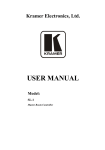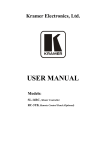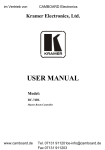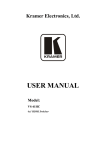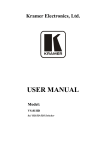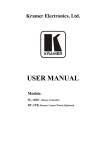Download USER MANUAL
Transcript
K R A ME R E LE CT R O N IC S L TD . USER MANUAL MODEL: SL-10 Master Room Controller P/N: 2900-000581 Rev 4 Contents 1 Introduction 1 2 2.1 2.2 2.3 3 3.1 Getting Started Achieving the Best Performance Safety Instructions Recycling Kramer Products Overview Defining the SL-10 Master Room Controller 2 2 3 3 4 5 4 4.1 4.2 4.3 4.4 4.5 5 Connecting the SL-10 Using the RC-4 IR Transmitter Connecting the RS-232 Interface Connecting the RS-485 Interface Connecting the Ethernet Port Connecting the K-NET Port Operating the SL-10 7 8 8 9 9 10 11 6 Technical Specifications 12 Figures Figure 1: SL-10 Master Room Controller Figure 2: Connecting the SL-10 Master Room Controller Figure 3: RS-232 Connection Figure 4: RS-485 Connection Figure 5: K-NET PINOUT Connection 5 8 9 9 10 SL-10 – Contents i 1 Introduction Welcome to Kramer Electronics! Since 1981, Kramer Electronics has been providing a world of unique, creative, and affordable solutions to the vast range of problems that confront video, audio, presentation, and broadcasting professionals on a daily basis. In recent years, we have redesigned and upgraded most of our line, making the best even better! Our 1,000-plus different models now appear in 11 groups that are clearly defined by function: GROUP 1: Distribution Amplifiers; GROUP 2: Switchers and Routers; GROUP 3: Control Systems; GROUP 4: Format/Standards Converters; GROUP 5: Range Extenders and Repeaters; GROUP 6: Specialty AV Products; GROUP 7: Scan Converters and Scalers; GROUP 8: Cables and Connectors; GROUP 9: Room Connectivity; GROUP 10: Accessories and Rack Adapters and GROUP 11: Sierra Products. Congratulations on purchasing your Kramer SL-10 Master Room Controller, which is ideal for the following typical applications: Controlling multimedia rooms, such as classrooms, auditoriums, conference rooms, and so on, while enabling remote control and management of the AV equipment Production studios, rental, and staging SL-10 - Introduction 1 2 Getting Started We recommend that you: Unpack the equipment carefully and save the original box and packaging materials for possible future shipment Review the contents of this user manual i 2.1 Go to http://www.kramerelectronics.com/support/product_downloads.asp to check for up-to-date user manuals, application programs, and to check if firmware upgrades are available (where appropriate). Achieving the Best Performance To achieve the best performance: Use only good quality connection cables (we recommend Kramer highperformance, high-resolution cables) to avoid interference, deterioration in signal quality due to poor matching, and elevated noise levels (often associated with low quality cables) Do not secure the cables in tight bundles or roll the slack into tight coils Avoid interference from neighboring electrical appliances that may adversely influence signal quality Position your Kramer SL-10 away from moisture, excessive sunlight and dust ! 2 This equipment is to be used only inside a building. It may only be connected to other equipment that is installed inside a building. SL-10 - Getting Started 2.2 Safety Instructions ! 2.3 Caution: There are no operator serviceable parts inside the unit Warning: Use only the Kramer Electronics input power wall adapter that is provided with the unit Warning: Disconnect the power and unplug the unit from the wall before installing Recycling Kramer Products The Waste Electrical and Electronic Equipment (WEEE) Directive 2002/96/EC aims to reduce the amount of WEEE sent for disposal to landfill or incineration by requiring it to be collected and recycled. To comply with the WEEE Directive, Kramer Electronics has made arrangements with the European Advanced Recycling Network (EARN) and will cover any costs of treatment, recycling and recovery of waste Kramer Electronics branded equipment on arrival at the EARN facility. For details of Kramer’s recycling arrangements in your particular country go to our recycling pages at http://www.kramerelectronics.com/support/recycling/. SL-10 - Getting Started 3 3 Overview The SL-10 is a highly versatile controller that acts as an all-in-one control processor for control of A/V equipment—especially projectors and associated equipment—in any room (such as classrooms, boardrooms, or auditoriums). It streamlines operations and simplifies control by integrating audio, video, and computer-video sources into a centralized system. The SL-10 features: An Ethernet port for controlling several AV products over ETH 2 general purpose I/O ports that can be configured as analog inputs, digital inputs, or digital outputs for interfacing with a variety of devices such as sensors, switches, LEDs, and relays 2 bidirectional RS-232 ports that control AV equipment such as projectors, LCD and PDP displays, power amplifiers, switchers and scalers 5 relay contact closure ports that control other room items related to the AV system such as raising and lowering drapes, the screen or the projector IR control on two inputs (one built-in receiver and the other on a 3.5mm mini jack) and three outputs (on terminal blocks) IR Learning that learns commands from any IR remote 1 RS-485 serial port Compatibility with Kramer Site-CTRL software for network remote control and management over the Ethernet port A K-NET™ control channel that connects compatible user interfaces and supplies power and control data over a single cable A USB port for uploading a configuration file Status LEDs for all functions Flexible control via Ethernet, K-NET™, RS-485, an IR sensor and external IR commands 4 SL-10 - Overview 3.1 Defining the SL-10 Master Room Controller This section defines the SL-10. Figure 1: SL-10 Master Room Controller # Feature Function 1 ETHERNET RJ-45 Connector Connects to the PC or other serial controller through computer networking LAN to control several AV products over Ethernet 2 DEFAULT Recessed Pushbutton Press to reset to factory default definitions: IP number 192.168.1.39, Mask – 255.255.0.0 Gateway – 0.0.0.0 First disconnect the power supply and then connect it again while pressing the DEFAULT button. The unit powers up and loads its memory with the factory default definitions and erases all stored presets 3 IR Output Terminal Blocks Connect to IR emitter cables (from 1 to 3) 4 GPI/O Terminal Blocks Connect to various analog and digital sensors (from 1 to 2) 5 RELAYS Terminal Blocks Connect to low-voltage relay-driven devices (from 1 to 5) 6 RS-232 Terminal Blocks Connect to the RS-232 devices (from 1 to 2) 7 RS-485 Terminal Block Pins B (-) and A (+) are for RS-485; Pin G may be connected to the shield (if required) SL-10 - Overview 5 # 8 Feature Function K-NET Connector PIN GND is for the Ground connection; PIN B (-) and PIN A (+) are for RS-485, and PIN +12V is for powering other units K-NET is a proprietary Kramer protocol for interconnecting Kramer units The ground connection is sometimes connected to the shield of the RS-485 cable (in most applications, it is not connected) Note that the SL-10 cannot receive power via the K-NET connector, but can power other units (but not another SL-10) 9 RS-485 TERM Switch Slides down for RS-485 termination, slides up for not terminated 10 K-NET TERM Switch Slides down for K-NET termination, slides up for not terminated 11 PROG. Switch For service use only 12 12V DC Socket 12V DC connector for powering the unit 13 IR INPUTS Built-in receiver and STATUS LED Accepts IR remote commands 3.5mm Mini Jack Connects to an external IR receiver 14 6 15 RELAY LEDs Illuminate when a relay is active (1 to 5) 16 IR LEDs Illuminate when an IR port is active 17 NET LED Illuminates when The Ethernet link is active 18 K-NET LED Illuminates while transmitting over K-NET 19 RS-485 LED Illuminates while transmitting/receiving on an RS-485 port 20 RS-232 (Tx/Rx) LEDs Illuminate while transmitting/receiving on an RS-232 port (1 to 2) 21 GPI/O LEDS Illuminate while transmitting/receiving on a general purpose I/O port (1 to 2) 22 PROGRAM USB Connector Connect to a computer for unit configuration and firmware upgrading SL-10 - Overview 4 Connecting the SL-10 i Always switch off the power to each device before connecting it to your SL-10. After connecting your SL-10, connect its power and then switch on the power to each device. To connect the SL-10 as illustrated in the example in Figure 2: 1. Connect the RELAY terminal block connectors as follows: Connect RELAY 1 and 2 to the projector lift Connect RELAY 3 and 4 to the screen Connect RELAY 5 to the lighting system 2. Connect the IR outputs as follows: Connect an IR emitter to IR OUTPUT 1 and attach the emitter to the DVD player 3. Connect the GPI/O ports as follows: Connect GPI/O 1 to motion detector 1 Connect GPI/O 2 to motion detector 2 4. Connect the RS-232 ports as follows: Connect RS-232 port 1 to the DVD player Connect RS-232 port 2 to the projector 5. Connect the IR input as follows: Connect IR INPUT 1 to an IR sensor (or alternatively connect IR INPUT 1 to an external IR receiver P/N: C- A35M/IRR two extension cables are also available: a 15 meter cable and a 20 meter cable. 6. Connect the RS-485 to several Kramer matrices, for example. Not shown in Figure 2. 7. Connect the Ethernet port to a network. SL-10 - Connecting the SL-10 7 8. Connect the K-NET port to any RC device with K-NET. Figure 2: Connecting the SL-10 Master Room Controller 4.1 Using the RC-4 IR Transmitter You can use the optional RC-4 IR transmitter as an auxiliary control panel and initiate configured control triggers—refer to the K-Config guide—via the built in IR receiver on the front panel, or instead, via an optional external wired IR receiver, which exists in several cable lengths (shown in Figure 2). 4.2 Connecting the RS-232 Interface To connect an AV device to the SL-10 using the RS-232 port, connect the RS-232 9-pin D-sub port on your device to the RS-232 terminal block on the rear panel of the SL-10 as shown in Figure 3: 8 SL-10 - Connecting the SL-10 Figure 3: RS-232 Connection 4.3 Connecting the RS-485 Interface To connect an AV device to the SL-10 using the RS-485 port, connect the RS-485 port on your device to the RS-485 terminal block on the rear panel of the SL-10 as shown in Figure 4: Figure 4: RS-485 Connection 4.4 Connecting the Ethernet Port The Ethernet connection of the SL-10 allows you to perform all control functions of the SL-10 over the Internet using a PC running the Kramer Site-CTRL control program. To connect the SL-10 to a network: 1. Connect the Ethernet port of the SL-10 to the Ethernet port on a network hub or network router, via a straight cable with RJ-45 connectors. 2. At the other end, connect the Internet to a PC running Site-CTRL. SL-10 - Connecting the SL-10 9 After connecting the Ethernet port, you have to install and configure it. For detailed instructions on how to install and configure your Ethernet port, see the K-Config Guide. Available for download at the Kramer Web site: www.kramerelectronics.com. 4.5 Connecting the K-NET Port The K-NET port is wired as shown in Figure 5. Figure 5: K-NET PINOUT Connection 10 SL-10 - Connecting the SL-10 5 Operating the SL-10 You can operate your SL-10 using: An RC family remote controller: To operate your device using an RC remote controller, see the Kramer K-Config Guide Available for download at the Kramer Web site: www.kramerelectronics.com The optional RC-4 infrared remote control transmitter: The RC-4 is configured via the Kramer K-Config software To operate your device using the infrared remote controller, see the User Manual packed with the remote controller A PC running Site-CTRL control software: To operate your device using Site-CTRL, see the Site-CTRL and Web Access Online User Guide SL-10 - Operating the SL-10 11 6 Technical Specifications INPUTS: 2 RS-232, RS-485, 2 GPI/O and K-NET on terminal block connectors; Ethernet on an RJ-45 connector; 1 infrared built-in receiver, 1 infrared on a 3.5mm mini jack connector; 1 USB for programming OUTPUTS: 3 infrared, 5 relays (36V AC or DC, 2A, 60VAC maximum on non-inductive load) and 2 GPI/O on terminal block connectors DEFAULT IP SETTINGS: IP number − 192.168.1.39; Mask – 255.255.0.0; Gateway – 0.0.0.0 INDICATORS: LED indicator for each function POWER CONSUMPTION: 12V DC, 550mA OPERATING TEMPERATURE: 0° to +40°C (32° to 104°F) STORAGE TEMPERATURE: -40° to +70°C (-40° to 158°F) HUMIDITY: 10% to 90%, RHL non-condensing DIMENSIONS: 14.3cm x 12.2cm x 4.4cm (5.6" x 4.8" x 1.7") W, D, H WEIGHT: 0.6kg (1.4lbs) ACCESSORIES: Power supply OPTIONS: RK-13 19” rack mount, RC-3 remote controller, IR emitter cables P/N: C-A35/IRE-10; two IR Emitter Extension Cables are also available: a 15 meter cable and a 20 meter cable, IR sensor cable P/N: 95-0104050 Specifications are subject to change without notice at http://www.kramerelectronics.com 12 SL-10 - Technical Specifications For the latest information on our products and a list of Kramer distributors, visit our Web site where updates to this user manual may be found. We welcome your questions, comments, and feedback. Web site: www.kramerelectronics.com E-mail: [email protected] ! P/N: SAFETY WARNING Disconnect the unit from the power supply before opening and servicing 2900- 000581 Rev: 4


















